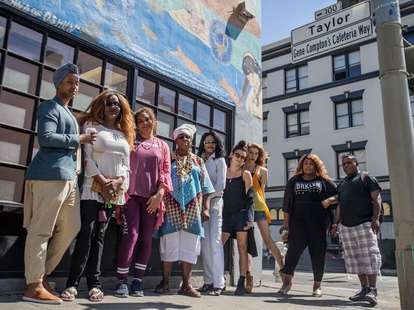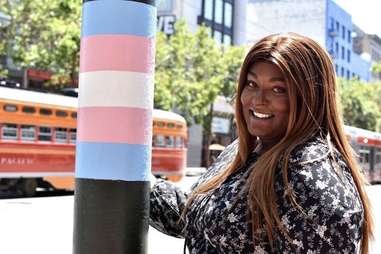The World’s First Official Transgender District Is a Game-Changer for LGBTQ Communities
Preserving the legacy of San Francisco’s trans community.

Three years before the Stonewall Rebellion in New York City, one of the first recorded transgender riots took place in the Tenderloin district of San Francisco. It was August, 1966, at Compton’s Cafeteria, a 24-hour dining hall that was a popular meeting spot for drag queens and trans residents in the neighborhood.
Cross-dressing was still illegal, and Gene Compton and his staff would often call the police to arrest customers on charges of “female impersonation.” One night, fed up with discriminatory service fees, blatant harassment, and police brutality, the cafeteria exploded into a two-day riot that would inspire transgender activists for decades to come.
The Tenderloin has a well-documented presence of queer and transgender residents for over a century. Known as the “gay ghetto” between the 1930s and 1960s, it was one of the few urban areas in America where trans people could be “out” with a relatively reduced risk of violence. The important aftermath of the Compton’s Cafeteria Riot was an emerging network of social, psychological, and medical support services for the trans community.
“I underestimated the feeling of being able to see yourself, or a part of yourself, be affirmed.”
Fast forward to 2015, when a proposed development at 915 Market Street would bring a new residential complex and hotel to the Tenderloin -- and likely displace long-term residents in the process.
A diverse coalition of queer activists came together to preserve the Tenderloin, with three Black trans women -- Aria Sa’id, Janetta Johnson, and Honey Mahogany -- leading the charge. Q Foundation, a neighborhood nonprofit that works to prevent homelessness for people living with HIV/AIDS, provided seed funding to begin the project.
Their efforts helped establish a section of the Tenderloin neighborhood as the world’s first-ever legally recognized transgender cultural district. Founded in 2017, it encompasses six blocks in the southeastern Tenderloin and crosses over Market Street to include two blocks of 6th Street.
And this spring, the area got a name change: originally Compton’s Transgender Cultural District, the name has been simplified to the Transgender District to avoid unintentionally honoring Gene Compton, the cafeteria owner who routinely endangered local drag queens, queer, and trans residents.
We sat down with Aria Sa’id, Co-founder and Executive Director of the Transgender District, to talk about what the district represents to San Francisco’s trans community, and their work in helping other trans communities protect their heritage.
Thrillist: Can you tell us about your connection with the Tenderloin neighborhood and what it’s meant to you as a Black trans woman?
Aria Sa’id: I took the Greyhound bus from Seattle and came to San Francisco with $60 in my bag when I was 19. I moved to San Francisco thinking that this was the city where I was going to be free, only to find that none of the trans people I knew had legal employment or housing. I wound up in the Tenderloin, like so many Black trans women do, and entered the survival sex economy -- was homeless, sleeping on the BART trains, etc. So having those roots in the Tenderloin and seeing us create something so much bigger than ourselves really shifted something for me as a trans person.
Looking back on Pride Month, has the new district changed how you and the local trans community participate in Pride in any way?
Sa’id: I never really connected to LGBT Pride because I always wondered what we were celebrating. Yes I was alive and breathing, but I wasn’t employed, I wasn’t proud, I was still being harassed on the streets and misgendered -- and those are just the smaller incidents of violence that trans people face, even in places like New York and San Francisco.
With the formation of the trans district, it really affirmed for me that there can be possibilities for us, specifically as Black trans women. I had never experienced so much pride walking down the street. I underestimated the feeling of being able to see yourself, or see a part of yourself, be affirmed. That is what we’re seeing a lot of trans people experience in the neighborhood.

Can you tell us a bit about how the district plans to serve communities living in the Tenderloin?
Sa’id: With the district, I think our work is different in that anything we do, of course it celebrates trans people, but we want it to have a benefit for the broader neighborhood and people who live there. Within San Francisco, the Tenderloin neighborhood has the most children under 18, in addition to huge Arab, Black, and Latinx populations. So we’ve also been advocating for things like more trash cans, repaved streets, and adding trees.
Has your community programming shifted since the COVID pandemic?
Sa’id: We are having to be really creative. Our work is really about bringing trans people together in person and creating these moments of tangible in-person support. It’s been a very complicated journey navigating that during COVID. From my understanding, we were the first trans-led project to lead a relief or mutual aid fund for trans people, and then we worked with other orgs across the country to replicate it for their own communities. We are still adapting and trying to figure out how to maintain community while also maintaining social distance.
We do have a lifetime lease agreement of a commercial space that we worked on two years ago. That’s in construction and our hope is that it will open in the fall and become the first trans-led social enterprise program.
Are you aware of any similar districts that are in development elsewhere in the country, or around the world?
Sa’id: We are the first legally recognized trans cultural district in the world, which we are still digesting. Something that we’ve started with two different trans-led groups, one in Atlanta and one in Austin, is to share our process of how we became a district and how we gained partnerships with local government. In doing so, it’s our hope that trans people [in other cities] can start saving and preserving their own communities.
Thanks so much for speaking with us, Aria. [This interview has been edited and condensed for clarity.]